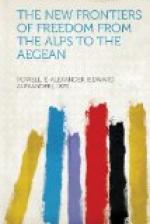I used to be of the opinion that Tiflis, in the Caucasus, was the most cosmopolitan city that I had ever seen, but since the war I think that the greatest variety of races could probably be found in Salonika. Sit at a marble-topped table on the pavement in front of Floca’s cafe at the tea-hour and you can see representatives of half the races in the world pass by—British officers in beautifully polished boots and beautifully cut breeches, astride of beautifully groomed ponies; Highlanders with their kilts covered by khaki aprons; raw-boned, red-faced Australians in sun helmets and shorts; swaggering chausseurs d’Afrique in wonderful uniforms of sky-blue and scarlet which you will find nowhere else outside a musical comedy; soldiers of the Foreign Legion with the skirts of their long blue overcoats pinned back and with mushroom-shaped helmets which are much too large for them; soldierly, well set-up little Ghurkas in broad-brimmed hats and uniforms of olive green, reminding one for all the world of fighting cocks; Sikhs in yellow khaki (did you know, by the way, that khaki is the Hindustani word for dust?) with their long black beards neatly plaited and rolled up under their chins; Epirotes wearing the starched and plaited skirts called fustanellas, each of which requires from twenty to forty yards of linen; Albanian tribal chiefs in jackets stiff with gold embroidery, with enough weapons thrust in their gaudy sashes to decorate a club-room; Cretan gendarmes wearing breeches which are so tight below the knee and so enormously baggy in the seat that they can, and when they are in Crete frequently do, use them in place of a basket for carrying their poultry, eggs or other farm produce to market; coal-black Senegalese, coffee-colored Moroccans and tan-colored Algerians, all wearing the broad red cummerbunds and the high red tarbooshes which distinguish France’s African soldiery; Italian bersaglieri with great bunches of cocks’ feathers hiding their steel helmets; Serbs in ununiform uniforms of every conceivable color, material and pattern, their only uniform article of equipment being their characteristic high-crowned kepis; Russians in flat caps and belted blouses, their baggy trousers tucked into boots with ankles like accordions; officers of Cossack cavalry, their tall and slender figures accentuated by their long, tight-fitting coats and their high caps of lambskin; Bulgar prisoners wearing the red-banked caps which they have borrowed from their German allies and Austrian prisoners in worn and shabby uniforms of grayish-blue; Greek soldiers bedecked like Christmas trees with medals, badges, fourrageres and chevrons, in the hope, I suppose, that their gaudiness would make up for their lack of prowess; Orthodox priests with their long hair (for they never cut their hair or beards) done up in Psyche knots; Hebrew rabbis wearing caps of velvet shaped like those worn by bakers; Moslem muftis with their snowy turbans encircled by green




